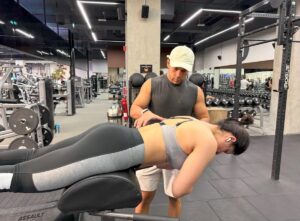Introduction
Bones are tissues – groups of cells that work together – that make up the skeleton. Bones look like dead things or fossils, but the bones in human body are alive. They grow and change all the time!
Bones support and hold up your body. Without bones your body would be a squishy blob on the ground. Bones help you move. Muscles work together with bones to move your body around.
Like any other tissue bone is constantly being broken down and replenished. When the creation of new bone doesn’t keep up with the loss of old bone, osteoporosis occurs. The worst consequences of osteoporosis are bone fractures, especially those that occur in the hip or spine. Hip fractures are frequently brought on by falls, and in the first year following the injury, they may induce disability or even raise the chance of mortality.
WHO has reported “Falls are the second leading cause of unintentional injury deaths worldwide. Each year an estimated 684 000 individuals die from falls globally”.
This article delves into the mechanisms by which weight training, a type of strength exercise, influences in enhancing bone strength and reducing the risk of fractures.
Why Do We Need Stronger Bones?
Bones keep our body healthy in many ways. Bones
1. Provide stability and support to our bodies
Without bones, we would just be mushy blobs on the earth.
2. Assist us with moving
Our bodies are moved by the combination of our muscles and bones.
3. Keep our organs safe
Certain bones protect our organs from harm. For instance, our skull shields our brain, while our ribs guard our heart and lungs.
4. Produce red blood cells
Bone marrow is a substance that resembles jelly that is found inside some types of bones. The bone marrow produces new blood cells!
5. Hold onto energy
Certain bone types such as the bones in our legs have cells that may store fat and release it when our bodies want energy.
6. Preserve vitamin D and minerals
Minerals like calcium, phosphorus, and vitamin D can be stored in the bones and released as necessary by the body.
Bone Density and Bone Health
Bone density is a critical marker of bone health. It is often overlooked until issues arise. It refers to the amount of bone mineral in bone tissue and is a key indicator of bone strength and overall skeletal health. It is typically measured using a DEXA scan (Dual-Energy X-ray Absorptiometry).
As stated above bone tissue is dynamic. It constantly remodels itself through two main processes: bone resorption (breakdown of old bone) and bone formation (creation of new bone). This balance is crucial for maintaining healthy bones throughout life.
As we age, particularly after the age of 30, bone resorption can outpace bone formation, leading to a gradual decline in bone density.
How Weight Training Affects Bone Density
Weight training, also known as resistance training, involves exercises that cause muscles to contract against an external resistance, such as weights, resistance bands, or body weight. The benefits of weight training on bone density are well-documented and occur through several mechanisms:
1. Mechanical Loading and Bone Formation
Weight training exerts mechanical stress on bones, which is a critical factor in stimulating bone formation. When muscles contract during weight-bearing exercises, they pull on the bones to which they are attached.
This mechanical load induces a response in bone cells called osteocytes. These cells sense the stress and signal other bone cells, like osteoblasts, to increase bone formation.
A landmark study by Turner and Robling (2003) demonstrated that mechanical loading through resistance exercises significantly enhances bone mass and density, particularly in the sites subjected to the highest loads, such as the hips and spine. This is crucial in preventing fractures in these vulnerable areas.
2. Hormonal Responses
Weight training also positively influences the endocrine system, which plays a critical role in bone metabolism. Resistance exercises increase the production of growth hormone and testosterone, both of which are anabolic hormones that promote bone and muscle growth.
According to Westcott (2012), regular resistance training elevates levels of insulin-like growth factor-1 (IGF-1), a hormone that promotes bone growth and remodeling.
These hormonal responses are particularly beneficial for postmenopausal women, who experience a decline in estrogen levels, a hormone that protects against bone loss.
3. Reduction in Bone Resorption
In addition to promoting bone formation, weight training has been shown to reduce bone resorption. Nelson et al. (1994) found that older women who engaged in weight training twice a week for a year had significant increases in bone density at the hip and spine compared to a control group.
The study also noted a decrease in bone resorption markers, suggesting that resistance training can slow down the breakdown of bone tissue.
4. Improved Balance and Reduced Fall Risk
Beyond direct effects on bone density, weight training improves muscle strength, balance, and coordination, which are crucial for reducing the risk of falls—a common cause of fractures in individuals with low bone density. Strengthening exercises for the lower body, such as squats and lunges, enhance stability and support the skeletal structure.
A study by Liu-Ambrose et al. (2004) found that a 12-month resistance training program improved balance and reduced fall risk in older women, highlighting the importance of weight training in fall prevention and, consequently, fracture prevention.
Research Evidence Supporting Weight Training for Bone Health
Multiple studies support the efficacy of weight training in improving bone density across various populations:
1. Kerr et al. (2017)
Conducted a meta-analysis of randomized controlled trials and concluded that resistance training significantly improves bone density in postmenopausal women, particularly at the lumbar spine and femoral neck.
2. Zhao et al. (2015)
Reviewed the effects of exercise on bone mineral density in men and found that weight-bearing and resistance exercises were effective in increasing bone mass, particularly in the lumbar spine.
3. Giangregorio et al. (2014)
Emphasized the importance of tailored resistance training programs, suggesting that higher-intensity weight training provides greater benefits for bone density compared to lower-intensity or non-weight-bearing exercises.
Practical Recommendations for Weight Training
For those looking to enhance bone density through weight training, here are some evidence-based guidelines:
1. Start Early, but It’s Never Too Late
While bone density is typically highest in young adulthood, engaging in weight training at any age can provide benefits. Postmenopausal women and older adults, in particular, should incorporate resistance exercises to slow down bone loss.
2. Focus on Weight-Bearing Exercises
Exercises that load the skeleton, such as squats, lunges, deadlifts, and overhead presses, are particularly effective in increasing bone density.
3. Progressive Overload
Gradually increasing the weight or resistance used in exercises is crucial for continued bone stimulation. Aim to increase the load as strength improves.
4. Consistency is Key
Regular weight training, at least two to three times a week, is necessary to see significant improvements in bone density.
5. Combine with Other Forms of Exercise
While weight training is highly effective, combining it with other forms of exercise like walking or running, can provide comprehensive benefits for overall health.
Benefits of Strength Training for Women
Everyone can benefit from strength training based on the same basic principle: increasing strength requires applying a load to a muscle that is heavy enough to cause the muscle to adapt. Strength training strengthens bones, maintains good joint alignment, enhances athletic performance, and lowers the chance of injury.
By incorporating strength training into her health program a woman gets significant advantages, such as stronger bones and fewer injuries.
Please see below the benefits of strength training for women from youth to older age.
1. Childhood and Adolescence
Seeds of osteoporosis are sown in infancy and adolescence, despite your initial belief to the contrary. During puberty, up to 40% of an adult’s total bone mass is acquired. This implies that later on in life, weak, fragile bones will be the result of inadequate bone formation during the early stages of life. Regular strength exercise is essential for girls and young women because it is a potent stimulator for bone growth.
2. Pregnancy and Postpartum
The musculoskeletal system experiences specific demands during pregnancy, necessitating alterations in the kinds and methods of workouts. As a pregnancy goes on, strength training for the hips, upper back, shoulders, and core might assist women adjust to their shifting centre of gravity. Many women who strength-trained before becoming pregnant can stick to their program through the first and even second trimester, unless there are issues and their doctor has instructed them to quit exercise.
Following childbirth, the pelvic floor muscles could also need rehabilitation and consistent training. In addition to helping you manage the physical demands of pregnancy, strength training done properly and under the supervision of professionals during pregnancy and after delivery can help you regain core and pelvic floor strength that can endure for a long time.
3. Post-Menopausal and Senior Years
It’s never too late to get stronger. Furthermore, having enough strength is necessary to stay active, maintain one’s independence, and prevent falls. Given that women are more likely than males to develop osteoporosis and that bone loss accelerates after menopause, strength training is especially crucial for older women. ability training in later life not only helps preserve bone mass but also enhances quality of life by providing the ability to support ageing joints, keep proper posture, lift grandchildren, and carry on with enjoyable sports and hobbies.
What Supplements are good for bone health?
One can take a few supplements to prevent or slow bone loss.
1. Calcium
Calcium hardens and strengthens bone. Our bodies cannot make calcium. We need to get calcium from foods and drinks, and supplements when needed, to build strong bones and teeth and to keep them healthy. Healthy bones are less likely to break if we fall.
Include recommended calcium in your diet and use supplements as required. For adults ages 19 to 50 and men ages 51 to 70, the Recommended Dietary Allowance (RDA) is 1,000 milligrams (mg) of calcium a day. The recommendation increases to 1,200 mg a day for women age 51 and older and for men age 71 and older.
2. Vitamin D
Pay attention to vitamin D. Body needs vitamin D to absorb calcium. For adults ages 19 to 70, the RDA of vitamin D is 600 international units (IUs) a day. The recommendation increases to 800 IUs a day for adults age 71 and older.
3. K2
Vitamin K is a group of nutrients divided into vitamins K1 and K2. Vitamin K1 is involved in blood coagulation, and vitamin K2 benefits bone and heart health. Vitamin K2 plays a central role in calcium metabolism, the main mineral found in bones and teeth. Vitamin K2 activates the calcium-binding actions of two proteins — matrix GLA protein and osteocalcin, which help to build and maintain bones.
4. Magnesium
Magnesium is essential for bones, but because it’s needed for many other functions, the body tightly regulates how much is in the blood. If intake is low, magnesium will be pulled from the bones to compensate.
Research suggests consuming more magnesium supports bone mineral density (BMD). Magnesium deficiency could interfere with bone formation and contribute to fracture risk from brittle bones because of its role in bone mineralization.
But magnesium doesn’t work alone. Since it’s a cofactor, it works with other nutrients—especially calcium and vitamin D—to support your bones. All three of these nutrients are essential for strong bones.
5. Omega-3
Important physiological functions, such as bone metabolism, are played by omega-3 EPA and DHA as well as lipid mediators produced from these fatty acids. Research has demonstrated that EPA and DHA supplements raise bone mineral density (BMD), reduce hip fracture risk, and positively correlate with indicators of bone turnover in people.
Conclusion
Weight training is a powerful tool for enhancing bone density and reducing the risk of osteoporosis and fractures. Through mechanical loading, hormonal responses, and reduction in bone resorption, resistance exercises stimulate bone formation and improve overall skeletal health.
With the growing body of research supporting its benefits, weight training should be considered an essential component of a comprehensive approach to bone health, especially for aging populations.
Incorporating weight training into regular exercise routines, alongside a balanced diet rich in calcium and vitamin D, can help maintain strong bones and prevent the debilitating effects of osteoporosis. As the science continues to evolve, it is clear that the role of weight training in promoting bone health cannot be overstated.
Whether you are young or old, male or female, incorporating these exercises into your daily routine can have significant benefits.
Please contact me Abhinav Malhotra to learn what I and my team AbhiFit can do for you through personal training and nutrition services. We train kids, teens, adults, elders, athletes and models in Dubai and online across the UAE and around the world. We help our clients achieve their fat loss, weight loss, muscle gain, strength gain, rehab, figure / physique transformation & healthy living goals.
Many female and male clients including kids, teens, adults and elderly people have greatly benefited from Abhinav’s strong experience as the best personal trainer and nutritionist in Dubai, UAE. You can see some of our client transformations here here.
Email your Name and WhatsApp No. to info@abhifit.com if you want to receive a notification whenever we publish a new article.
Get Fit Now!
References
1. National Institute of Arthritis and Musculoskeletal and Skin Diseases. “Learning about Bones”
2. Turner, C. H., & Robling, A. G. (2003). “Mechanisms by which exercise improves bone strength.”
3. Hospital for Special Surgery. “Benefits of Strength Training for Women Throughout Life.”
4. Westcott, W. L. (2012). “Resistance training is medicine: effects of strength training on health.”
5. Nelson, M. E., Fiatarone, M. A., Morganti, C. M., Trice, I., Greenberg, R. A., & Evans, W. J. (1994). “Effects of high-intensity strength training on multiple risk factors for osteoporotic fractures: A randomized controlled trial.”
6. Liu-Ambrose, T., Khan, K. M., Eng, J. J., Lord, S. R., & McKay, H. A. (2004). “Balance confidence improves with resistance or agility training.”
7. Kerr, D., Ackland, T., Maslen, B., Morton, A., & Prince, R. (2017). “Resistance training over eight months increases bone mass in elderly women.”
8. Zhao, R., Zhao, M., & Zhang, L. (2015). “Efficiency of jumping exercise in improving bone mineral density among premenopausal women: a meta-analysis.”
9. Giangregorio, L. M., et al. (2014). “Too Fit to Fracture: outcomes of a Delphi consensus process on physical activity and exercise recommendations for adults with osteoporosis with or without vertebral fractures.”
10. Sara Castiglioni 1,Alessandra Cazzaniga 1,Walter Albisetti 2 andJeanette A. M. Maier. “Magnesium and Osteoporosis: Current State of Knowledge and Future Research Directions”
11. WHO. Falls – Key Facts








